Gumby and Pokey
Claymation
He has a strange bump on his head, googly red eyes and bell-bottom legs. He's
green and made of clay and beeswax. His image has sold tens of millions of dollars worth
of merchandise. He's not just a kid hero nor simply a badly-animated cartoon character,
but a Zen Buddhist spiritual master as well. He's Gumby.
Gumby was the creation of Art Clokey, a former Episcopal seminar student who joined the
film program at the University of Southern California for a few years before dropping out
when given the opportunity to animate vegetables for soup commercials.
In 1953, Clokey started playing with colorful plasticine clay and film. He laboriously
made a four minute animated art film he called "Gumbasia" in honor of Disney's
Fantasia which featured geometric shapes rolling and dancing to a jazz score.
"Suddenly I saw a kinetic force at work, what I call the Phi Phenomenon, which is an
impact on the nervous system brought about by images and the way they're edited,"
says Clokey.
But Sam Engel saw money. Engel was a film producer at 20th Century-Fox whose teenage son
Clokey was tutoring in English and Latin. When he showed Engel his Gumbasia film, Engel
said, "That's the most fantastic thing I've ever seen!" and asked if Clokey
could come up with some kid films for the emerging medium of TV.
Clokey went home and started experimenting, molding hundreds of shapes in different
colors. He found that clay characters didn't last very long under constant handling under
the heat of movie lights. Clokey came up with a simple character that could be cut out of
clay with a homemade cookie cutter so that it could be replaced every few hours (in 20
seconds of screen time, which can take a day's work to film, a character usually had to be
replaced five or more times).
Clokey made his clay character with a protrusion on one side of his head, modeled after a
photo he had of his father as a teenager with a huge cowlick hair lump. His friend,
American Zen philosopher Alan Watt, suggested that it was the "bump of wisdom that
the Buddhists have." In that spirit, Clokey made the new character green with a touch
of blue to suggest a field of grass under a blue sky. To provide yin for his character's
yang, he created a down-to-earth horse sidekick, colored an earthy orange- brown.
Clokey remembered that his father used to call the sticky, muddy clay around their farm in
Michigan "gumbo." Latin teacher Clokey knew that the diminutive of
"gumbo" would be "gumby," so that's the name he gave his new blue
character. ("That was the first and last significant use I made of my seven years of
Latin in school," he observed later.) Based on Watt's observation that there are two
kinds of people in the world, the prickly and the gooey, Clokey created two more
characters, a dinosaur named Prickle and a teardrop-shaped "what's-it" named
Goo. Finally, for Gumby and sidekick Pokey, Clokey created a miniature hang-out called the
Zen Cafe.
Clokey started creating a series of 130 surreal six-minute Gumby episodes, He would move
his characters a fraction of a millimeter and shoot a movie frame
and do it again and again, 24 times for each second of actual cartoon. He commissioned a
theme song from a young musician named Pete Kleinow, who later went on to become steel
guitarist for the Flying Burrito Brothers country rock group.
The series was picked up by NBC for the Howdy Doody Show. Gumby proved so popular he was
spun off into his own show which was hosted by comedian Pinky Lee.
Gumby started generating a lot of money. The problem was, Clokey wasn't getting much of
it. He was paid a straight salary of $200 a week to write and produce the Gumby episodes.
(That went up to $350 a week shortly before the Gumby Show was canceled in 1957.)
For eight years, he refused to license the Gumby image for merchandising. "I was a
very idealistic person," he says, "and I didn't want to exploit children."
That changed after Gumby's show left NBC and Clokey bought all rights back from the
network. His Prema (Sanskrit for "universal love") Toy Corporation started
manufacturing Gumby dolls and toys in 1964, the year that Gumby found new life in
syndication and Clokey started getting rich.
Not long after, however, his personal life fell apart, and so did his fortune. He went
through painful and expensive divorce proceedings with his wife of 18 years in 1966, about
the time that TV stations began dropping Gumby in favor of newer and slicker kid shows.
Clokey invested his last dollars in a new venture--a flexy-faced doll called Moody Rudy--
that bombed. His house went into foreclosure. In 1974, his daughter died in a car crash.
Clokey went into heavy therapy and began "looking at various gurus" before
adopting the teachings of Indian Swami Muktananda.
Clokey remarried in 1976 and three years later, he and his new wife Gloria traveled to
Bangalore, India to visit a guru named Sathya Sai Baba who supposedly had amazingly
magical powers. For some reason, Clokey brought a Gumby doll along to their audience with
the guru. "I stood there with Gumby and he did this circular motion with his
arms," Clokey says. "Out of nowhere he materialized this sacred ash. He plopped
it right on top of Gumby. When we came home again, things started to happen." Gumby
toy sales began to pick up, and then Eddie Murphy started doing a continuing Gumby skit on
Saturday Night Live.. Suddenly, the phone started ringing and Gumby was hip again. Clokey
went on a lecture tour and received an $8 million contract with Lorimar for a new Gumby
series. He started work on Gumby--the Movie.
"Gumby is a symbol of the spark of divinity in each of us, the basis of the ultimate
value of each person. Eddie Murphy instinctively picked up on this when he asserted, 'I'm
Gumby, dammit!'" wrote Clokey in 1986. "When people watch Gumby, they get a
blissful feeling. Gumby loves you. We love you. That's about all I can say."
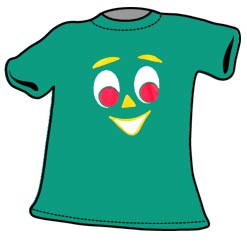
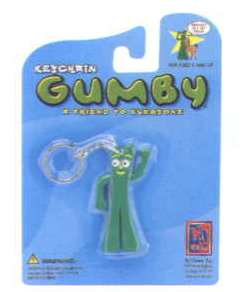
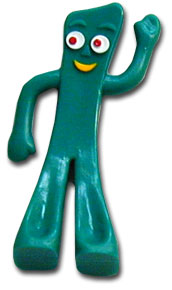
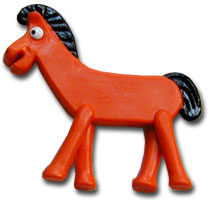
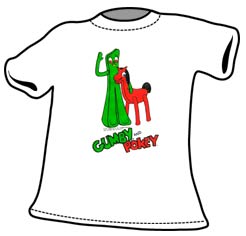
Are you a
Gumby and Pokey fan? Click here for Gumby merchandise










